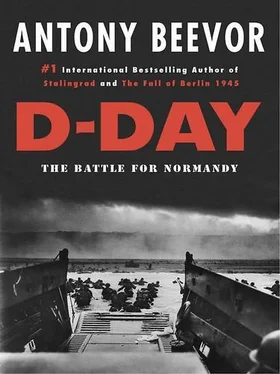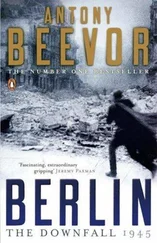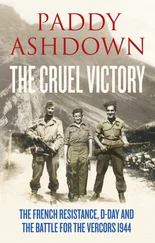Antony Beevor
D-DAY
The Battle for Normandy
Southwick House is a large Regency building with a stucco façade and a colonnaded front. At the beginning of June 1944, five miles to the south, Portsmouth naval base and the anchorages beyond were crowded with craft of every size and type — grey warships, transport vessels and hundreds of landing craft, all tethered together. D-Day was scheduled for Monday, 5 June, and loading had already begun.
In peacetime, Southwick could have been the setting for an Agatha Christie house party, but the Royal Navy had taken it over in 1940. Its formerly handsome grounds and the wood behind were now blighted by rows of Nissen huts, tents and cinder paths. Southwick served as the headquarters of Admiral Sir Bertram Ramsay, the naval commander-in-chief for the invasion of Europe, and also as the advanced command post of SHAEF, the Supreme Headquarters Allied Expeditionary Force. Anti-aircraft batteries on the Portsdown ridge were positioned to defend it as well as the dockyards below from the Luftwaffe.
Southern England had been enjoying a heatwave compounded by drought. Temperatures of up to 100 degrees Fahrenheit had been recorded on 29 May, yet the meteorological team attached to General Dwight D. Eisenhower’s headquarters soon became uneasy. The group was headed by Dr James Stagg, a tall, lanky Scot with a rather gaunt face and a neat moustache. Stagg, the leading civilian weather expert in the country, had just been given the rank of group captain in the RAF to lend him the necessary authority in a military milieu unused to outsiders.
Since April, Eisenhower had been testing Stagg and his team by demanding three-day forecasts delivered on a Monday which were then checked against the reality later in the week. On Thursday, 1 June, the day before the battleships were due to sail from Scapa Flow off the north-west tip of Scotland, weather stations indicated some deep depressions forming over the North Atlantic. Rough seas in the English Channel could swamp the landing craft, to say nothing of their effect on the soldiers cramped on board. Low cloud and bad visibility presented another great threat, since the landings depended on the ability of the Allied air forces and navies to knock out German coastal batteries and defensive positions. General embarkation for the first wave of 130,000 troops was under way and due to be completed in two days’ time.
Stagg was plagued by a lack of agreement among the different British and American meteorological departments. They all received the same reports from the weather stations but their analysis of the data simply did not match up. Unable to admit this, he had to tell Major General Harold R. Bull, Eisenhower’s assistant chief of staff, that ‘the situation is complex and difficult’.
‘For heaven’s sake, Stagg,’ Bull exploded. ‘Get it sorted out by tomorrow morning before you come to the Supreme Commander’s conference. General Eisenhower is a very worried man.’ Stagg returned to his Nissen hut to pore over the charts and consult the other departments yet again.
Eisenhower had other reasons for ‘pre-D-Day jitters’. Although outwardly relaxed, with his famous open smile for everyone whatever their rank, he was smoking up to four packs of Camel cigarettes a day. He would light a cigarette, leave it smouldering in an ashtray, jump up, walk around and light another. His nerves were not helped by constant pots of coffee.
Postponing the invasion carried many risks. The 175,000 soldiers in the first two waves risked losing their fighting edge if cooped up in rough weather on their ships and landing craft. The battleships and convoys about to head down British coasts towards the Channel could not be turned round more than once without needing to refuel. And the chances of German reconnaissance aircraft sighting them would increase enormously.
Secrecy had always been the greatest concern. Much of the southern coast was covered with elongated military camps known as ‘sausages’, where the invasion troops were supposedly sealed off from contact with the outside world. A number of soldiers had, however, been slipping out under the barbed wire for a last drink at the pub or to see sweethearts and wives. The possibilities of leaks at all levels were innumerable. An American air force general had been sent home in disgrace after indicating the date of Operation Overlord at a cocktail party in Claridge’s. Now a fear arose that the absence from Fleet Street of British journalists called forward to accompany the invasion force might be noticed.
Everyone in Britain knew that D-Day was imminent, and so did the Germans, but the enemy had to be prevented from knowing where and exactly when. Censorship had been imposed on the communications of foreign diplomats from 17 April, and movement in and out of the country strictly controlled. Fortunately, the British security service had captured all German agents in Britain. Most of them had been ‘turned’ to send back misleading information to their controllers. This ‘Double Cross’ system, supervised by the XX Committee, was designed to produce a great deal of confusing ‘noise’ as a key part of Plan Fortitude. Fortitude was the most ambitious deception in the history of warfare, a project even greater than the maskirovka then being prepared by the Red Army to conceal the true target of Operation Bagration, Stalin’s summer offensive to encircle and smash the Wehrmacht’s Army Group Centre in Belorussia.
Plan Fortitude had several aspects. Fortitude North, with fake formations in Scotland based on a ‘Fourth British Army’, pretended to prepare an attack on Norway to keep German divisions there. Fortitude South, the main effort, set out to convince the Germans that any landings in Normandy were a large-scale diversion to draw German reserves away from the Pas-de-Calais. The real invasion was supposedly to come between Boulogne and the Somme estuary during the second half of July. A notional ‘1st US Army Group’ under General George S. Patton Jr, the commander the Germans feared the most, boasted eleven divisions in south-east England. Dummy aircraft and inflatable tanks, together with 250 fake landing ships, all contributed to the illusion. Invented formations, such as a 2nd British Airborne Division, had been created alongside some real ones. To increase the illusion, two fake corps headquarters also maintained a constant radio traffic.
One of the most important double agents to work for British intelligence on Fortitude South was a Catalan, Juan Pujol, who had the codename ‘Garbo’. With his security service handler, he constructed a network of twenty-seven completely fabricated sub-agents and bombarded the German intelligence station in Madrid with information carefully prepared in London. Some 500 radio messages were sent in the months leading up to D-Day. These provided details which together gradually made up the mosaic which the Double Cross Committee was assembling to convince the Germans that the main attack was to come later in the Pas-de-Calais.
Subsidiary deceptions to prevent the Germans moving troops to Normandy from other parts of France were also dreamed up. Plan Ironside conveyed the impression that two weeks after the first landings a second invasion would be launched on the west coast of France directly from the United States and the Azores. To keep the Germans guessing, and to prevent them moving the 11th Panzer-Division near Bordeaux north into Normandy, a controlled agent in Britain, known as ‘Bronx’, sent a coded message to her German controller in the Banco Espirito Santo in Lisbon: ‘ Envoyez vite cinquante livres. J’ai besoin pour mon dentiste .’ This indicated ‘that a landing would be made in the Bay of Biscay on about the 15th June’. The Luftwaffe, clearly fearful of a landing in Brittany, ordered the immediate destruction of four airfields close to the coast. Another diversion, Operation Copperhead, was mounted in late May when an actor resembling General Montgomery visited Gibraltar and Algiers to suggest an attack on the Mediterranean coast.
Читать дальше











